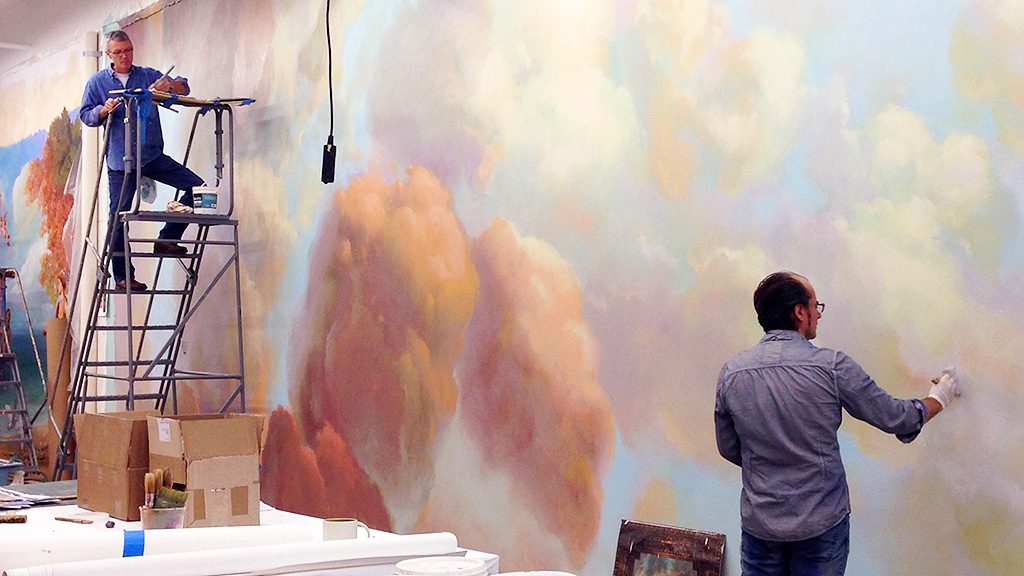April 10 – May 30, 2021 by appointment Sa-Su, 12pm-5pm
The exhibition has work outdoors and indoors, the interior is viewable from an outdoor space, instructions will be provided on site.

A Sunset Mistaken for the Dawn[1]
Niche Gallery is thrilled to present the debut exhibition of R. Geste.
At the heart of Geste’s layered and multi-disciplinary installation is a word: LUFTMENSCH, woven into a tapestry snugly fitted to the niche, and stacked, scrambled, encircled, fragmented across a series of tall pillar like canvases.
Like many Germanic words, it cobbles together multiple meanings to serve a variety of functions, and when used in the Yiddish tradition,[2] a proper filter of judgement, morality and familial obligation settles over this mouthful of consonants. Luftmensch literally translates to “air man”, a person whose head is stuck in the clouds. To be a mensch is good, honorable, right. To be a luftmensch, is impractical, out of touch with day-to-day responsibilities and obligations. The difference is in the air.
A bucolic pastel-hued sunset[3] serves as the background in Geste’s canvas totems, and an abstract pixelated series of cloud-like shapes line the margins of her weaving. Sky, clouds, air—always provide a versatile backdrop. Ubiquitous in our daily lives, sublime in our collective conscious and unconscious, these forms regularly decorate the ceilings of chapels and great institutions of learning, and just as often line the entryways of malls and brighten up dog parks—the sky is a great equalizer, part cliché, part perfect sign. Here, air elevates, aspires and levels.
In both cases, the tropes are familiar—the studious scholar who spends their days reading and commenting on ancient and primary texts, often oblivious to and unmoored from the world that surrounds them, and the serenely reliable setting sun, symbolizing the end to another day, the promise of a new one to come. For Geste, these ideas straddle the place between attraction and repulsion, meaning and interpretation. To be an air man doesn’t sound so bad.
In A Sunset Mistaken for the Dawn, visitors are greeted by a fragmented image of a setting sun uncannily set against the sky itself, and different arrangements of the letters that spell luftmensch. Clarity drifts in and out of view, words form and disappear, the edge of one canvas completes another when standing just so. The text appears again in the indoor niche, this time woven like bricks laid one on top of another, a composition formed slowly from the ground up. Here, Geste shifts meaning once more, highlighting how language depends on the gestalt of the experience—one pull, and the word might disappear into thin air.
R. Geste is a multidisciplinary practice that investigates concepts of abstraction both visually and through the dynamics of language and the poetic. The name R. Geste was devised as a pseudonym for the artist by five women and acts as a tool to question authorship and gender in the perception of visual work. Utilizing the sculptural and rooted in the histories of non-objective painting and traditional textiles, the work embraces such diverse subjects as the outdated, idiosyncratic uses of language and typography, popular music, humor and film references. An ordinariness of materials is not hidden but celebrated, combining and layering the everyday to get to a complexity of form. Pursuing the ineffable through traditional craft and the non-rational, R. Geste embraces a tension of idealist and defeatist dichotomies and scavenges poetry from the absurd.
[1] An adaptation of a quote that Claude Debussy said about Richard Wagner’s music. The actual quote was, “A beautiful sunset that is mistaken for a dawn.”
[2] Geste was first introduced to the term by her father, who, among several interpretations suggested that it could even be translated to mean someone who made their money seemingly out of thin air. A generation removed from Yiddish speakers, it’s very possible that this meaning twisted and turned into being from his own experience and not from popular use.
[3] The image of the sky comes from The New York Public Library’s historic Rose Main Reading Room, painted by James Wall Finn and completed in 1911. The mural was recreated in 2014, and finished in 2016, as seen in the image above.